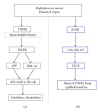Characterization of Virulence Factors of Staphylococcus aureus: Novel Function of Known Virulence Factors That Are Implicated in Activation of Airway Epithelial Proinflammatory Response
- PMID: 22567334
- PMCID: PMC3335658
- DOI: 10.4061/2011/601905
Characterization of Virulence Factors of Staphylococcus aureus: Novel Function of Known Virulence Factors That Are Implicated in Activation of Airway Epithelial Proinflammatory Response
Abstract
Airway epithelial cells play a major role in initiating inflammation in response to bacterial pathogens. S. aureus is an important pathogen associated with activation of diverse types of infection characterized by inflammation dominated by polymorphonuclear leukocytes. This bacterium frequently causes lung infection, which is attributed to virulence factors. Many of virulence determinants associated with S. aureus-mediated lung infection have been known for several years. In this paper, we discuss recent advances in our understanding of known virulence factors implicated in pneumonia. We anticipate that better understanding of novel functions of known virulence factors could open the way to regulate inflammatory reactions of the epithelium and to develop effective strategies to treat S. aureus-induced airway diseases.
Figures

References
-
- Aires De Sousa M, De Lencastre H. Bridges from hospitals to the laboratory: genetic portraits of methicillin-resistant Staphylococcus aureus clones. FEMS Immunology and Medical Microbiology. 2004;40(2):101–111. - PubMed
-
- Lowy FD. Staphylococcus aureus infections. The New England Journal of Medicine. 1998;339:520–532. - PubMed
-
- Foster TJ, Höök M. Surface protein adhesins of Staphylococcus aureus . Trends in Microbiology. 1998;6(12):484–488. - PubMed
LinkOut - more resources
Full Text Sources

